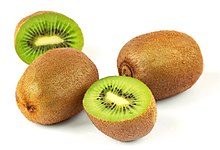
Back Baya AN ثمرة لبية Arabic Baga AST Baia Catalan Bobule Czech Çырла CV Bær Danish Beere German Jagoda DSB Ράγα (βοτανική) Greek


In botany, a berry is a fleshy fruit without a stone (pit) produced from a single flower containing one ovary. Berries so defined include grapes, currants, and tomatoes, as well as cucumbers, eggplants (aubergines), persimmons and bananas, but exclude certain fruits that meet the culinary definition of berries, such as strawberries and raspberries. The berry is the most common type of fleshy fruit in which the entire outer layer of the ovary wall ripens into a potentially edible "pericarp". Berries may be formed from one or more carpels from the same flower (i.e. from a simple or a compound ovary). The seeds are usually embedded in the fleshy interior of the ovary, but there are some non-fleshy exceptions, such as Capsicum species, with air rather than pulp around their seeds.
Many berries are edible, but others, such as the fruits of the potato and the deadly nightshade, are poisonous to humans.
A plant that bears berries is said to be bacciferous or baccate[a] (from Latin bacca).
In everyday English, a "berry" is any small edible fruit. Berries are usually juicy, round, brightly coloured, sweet or sour, and do not have a stone or pit, although many small seeds may be present.[1]
Cite error: There are <ref group=lower-alpha> tags or {{efn}} templates on this page, but the references will not show without a {{reflist|group=lower-alpha}} template or {{notelist}} template (see the help page).